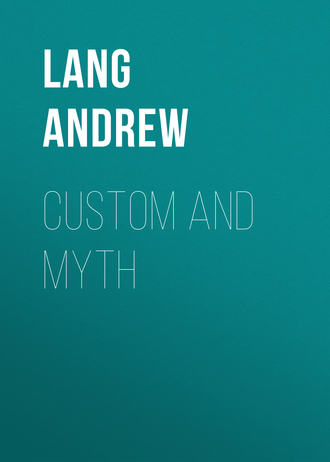
Lang Andrew
Custom and Myth
We have tried to show how savage decorative art supplied the first ideas of patterns which were developed in various ways by the decorative art of advancing civilisation. The same progress might be detected in representative art. Books, like the guide-book to ancient Greece which Pausanias wrote before the glory had quite departed, prove that the Greek temples were museums in which the development of art might be clearly traced. Furthest back in the series of images of gods came things like that large stone which was given to Cronus when he wished to swallow his infant child Zeus, and which he afterwards vomited up with his living progeny. This fetich-stone was preserved at Delphi. Next came wild bulks of beast-headed gods, like the horse-headed Demeter of Phigalia, and it seems possible enough that there was an Artemis with the head of a she-bear. Gradually the bestial characteristics dropped, and there appeared such rude anthropomorphic images of Apollo – more like South Sea idols than the archer prince – as are now preserved in Athens. Next we have the stage of semi-savage realism, which is represented by the metopes of Selinus in Sicily, now in the British Museum, and by not a few gems and pieces of gold work. Greek temples have fallen, and the statues of the gods exist only in scattered fragments. But in the representative collection of casts belonging to the Cambridge Archæological Museum, one may trace the career of Greek art backwards from Phidias to the rude idol.
‘Savage realism’ is the result of a desire to represent an object as it is known to be, and not as it appears. Thus Catlin, among the Red Indians, found that the people refused to be drawn in profile. They knew they had two eyes, and in profile they seemed only to have one. Look at the Selinus marbles, and you will observe that figures, of which the body is seen in profile, have the full face turned to the spectator. Again, the savage knows that an animal has two sides; both, he thinks, should be represented, but he cannot foreshorten, and he finds the profile view easiest to draw. To satisfy his need of realism he draws a beast’s head full-face, and gives to the one head two bodies drawn in profile. Examples of this are frequent in very archaic Greek gems and gold work, and Mr. A. S. Murray suggests (as I understand him) that the attitude of the two famous lions, which guarded vainly Agamemnon’s gate at Mycenæ, is derived from the archaic double-bodied and single-headed beast of savage realism. Very good examples of these oddities may be found in the Journal of the Hellenic Society, 1881, pl. xv. Here are double-bodied and single-headed birds, monsters, and sphinxes. We engrave three Greek gems from the islands as examples of savagery in early Greek art. In the oblong gem the archers are rather below the Red Indian standard of design. The hunter figured in the first gem is almost up to the Bushman mark. In his dress ethnologists will recognise an arrangement now common among the natives of New Caledonia. In the third gem the woman between two swans may be Leda, or she may represent Leto in Delos. Observe the amazing rudeness of the design, and note the modern waist and crinoline. The artists who engraved these gems on hard stone had, of necessity, much better tools than any savages possess, but their art was truly savage. To discover how Greek art climbed in a couple of centuries from this coarse and childish work to the grace of the Ægina marbles, and thence to the absolute freedom and perfect unapproachable beauty of the work of Phidias, is one of the most singular problems in the history of art. Greece learned something, no doubt, from her early knowledge of the arts the priests of Assyria and Egypt had elaborated in the valleys of the Euphrates and the Nile. That might account for a swift progress from savage to formal and hieratic art; but whence sprang the inspiration which led her so swiftly on to art that is perfectly free, natural, and god-like? It is a mystery of race, and of a divine gift. ‘The heavenly gods have given it to mortals.’







